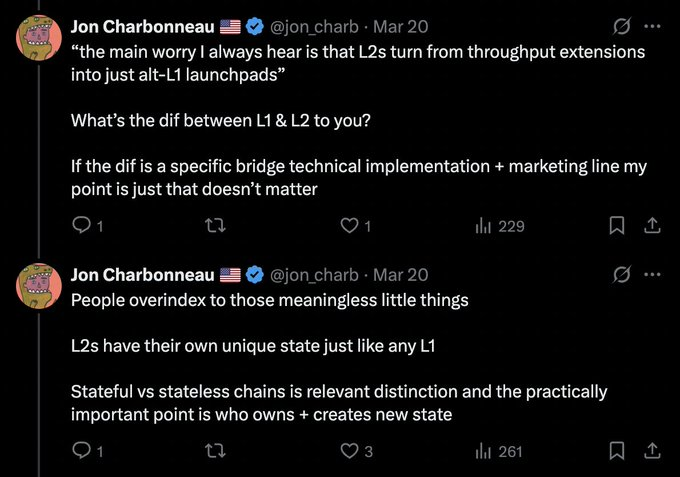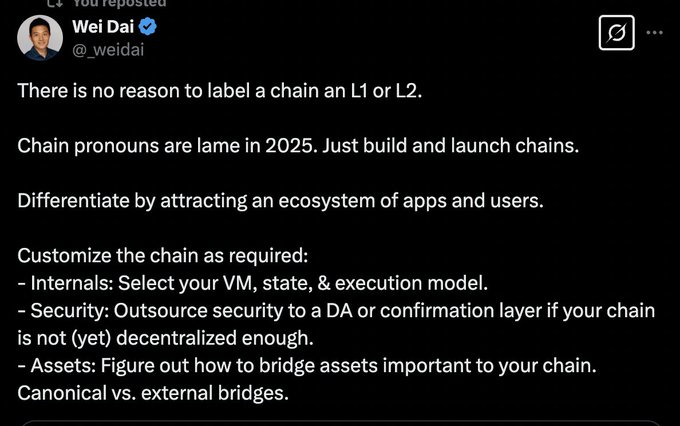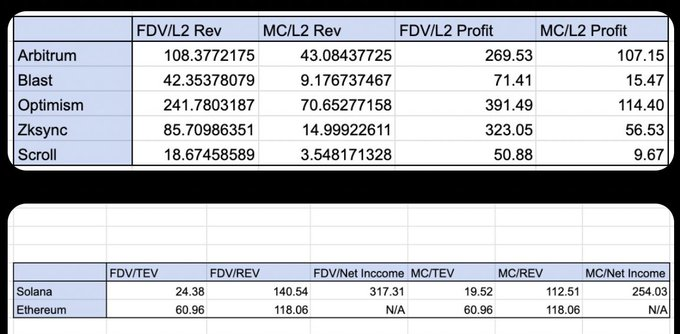
The tweet roughly means: People are worried that L2 will become an L1 launcher instead of an expansion solution. So what exactly is the difference between L2 and L1?

The tweet roughly means: The generational division of chains in 2025 is outdated, and there's no need to distinguish between L1 and L2. The real difference is in users and ecosystems.
You should read these tweets 100 times.
From the end-user perspective, there are no product differences between L1 and L2. There are also no fundamental differences in liquidity. A new L1 must launch by bridging stablecoins or non-native assets to its chain. Similarly, an L2 also needs to bridge stablecoins or non-native assets to its chain. The difference with L2 is that it obtains a trust-minimized bridge from L1, whereas Alt-L1s do not have such a mechanism and must rely on cross-chain message bridges. We have clearly seen that some whales are very sensitive to these trust assumptions, but many ordinary users don't care.
A perspective from the middle-ground group (mainly from Alt-L1 teams) insists that "L2 will cause liquidity fragmentation".
An L2 only allows trust-minimized bridging from L1, but every L2 launched today will connect with Alt-L1s and other L2s.

Every legitimate L2 deploys a cross-chain message bridge upon launch. Any user connected to the base chain (such as ETH, Solana) can use this as a relay for large asset transfers between Alt-L1s and L2s. If an Alt-L1 doesn't have its own L2, this might make liquidity outflow difficult, but if it integrates a cross-chain message bridge, it creates a paradox.
The essence of an L2 product is not defined by its association with L1. It is merely an execution layer, just like other execution layers with different characteristics.
So, why are L1s more valuable?
Viewed from two perspectives.
1. Perspective One: Valuation Logic of L1/L2 in Primary and Secondary Markets
a. Similar Valuation Logic in Secondary Markets
L1 networks have higher activity. Solana/ETH's valuation is about 100 times annual revenue, while mature L2 valuations are similar (10-200 times). (Data from October 2024, but the argument still stands).

As shown by the fundamental valuation multiples, mature L1s and mature L2s currently trade at relatively similar valuation multiples (Arbitrum/Optimism vs. Solana/Ethereum).
b. Different Valuation Logic in Primary Markets
Compared to secondary markets, primary markets have more unexplained extreme valuation multiple outliers. In other words, projects with valuations reaching billions of dollars exist despite low trading activity, a phenomenon more common in primary markets than secondary markets.
Representative Projects
- L1: Sui, Mantra, Pi, ICP, IP (and many old projects from different periods)
- L2: MOVE
In my view, this was an initial misunderstanding in the L2 project framework. Arbitrum and Optimism positioned themselves as Ethereum's expansion networks, serving as execution layers to help ETH scale. This positioning, combined with Ethereum's "Rollup-centric roadmap", was indeed an excellent cold start strategy.
However, the drawback of this approach is that it limits the entire target market to the Ethereum user base, thereby restricting the potential total liquidity, industry awareness, and revenue scale these chains (like Arbitrum/OP) can capture. Although Arbitrum and Optimism are fully capable of attracting entirely new decentralized applications and ecosystem participants (including those who have never touched Ethereum), their initial go-to-market (GTM) strategy overly emphasized being "Ethereum's expansion network". This positioning caused the market to always view them as Ethereum's subsidiary ecosystem (and thus their valuation was seen as a percentage of Ethereum's value). To be fair, when these teams launched, Ethereum was the only mainstream ecosystem in the market.
2. Perspective Two: Token Model
An L1 token model has a fundamental network flywheel effect. When L1 chain activity increases, it directly drives demand for tokens from two independent participant types: on-chain speculators and stakers.
The more frequent the on-chain activity, the more fees on-chain speculators are willing to pay to include transactions in a block. The uncertainty brought by diversified activities actually increases the probability, frequency, and scale of wealth opportunities, triggering people to compete for these opportunities. In terms of staking, the more fees a blockchain earns, the more people are willing to stake its native token to gain exposure to these economic returns. Additionally, on-chain activity is often related to net new asset issuance, and these assets are typically paired with native tokens, requiring people to buy these native tokens to participate in related trading activities (e.g., using ETH to mint NFTs, using SOL to buy meme coins).

How Should L2s Address These Issues?
Shift Mindset
L2s need to clearly decide: to be an L2 focused on ecosystem collaboration or to attract users from any source? L2 construction should fully leverage its unique second-layer technical advantages (trustworthy/custom block construction, performance optimization, shareable profits).
Optimize Token Economic Model
L2s should optimize their token economic model to create a flywheel effect where network activity growth stimulates token demand on both supply and demand sides. The current L2 attempts to use custom gas tokens solve incentive issues in on-chain speculation but fail to let stakers share these returns. Theoretically, since most L2s direct sequencer revenues to DAO treasuries, and tokens control these treasuries, this effectively fairly distributes revenues to token holders. However, to achieve the same effect at the token holder perception level, more comprehensive governance rights must be granted to token holders.






